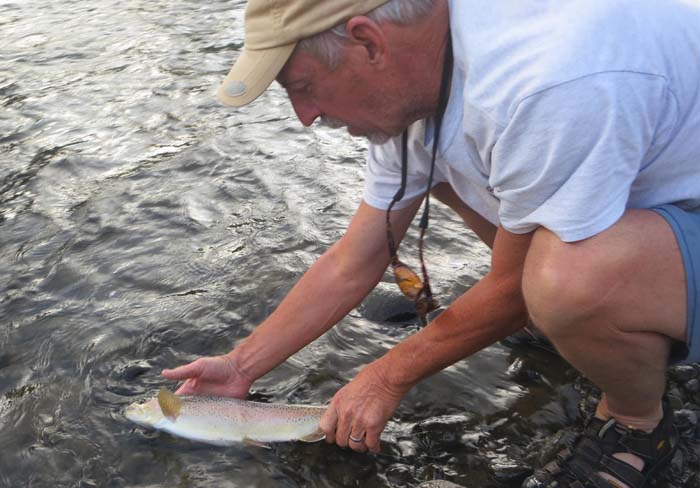The natural world: Tempting Wallowa River redsides with flies
Published 7:00 am Saturday, August 7, 2021

- Dennis Dauble releases a 18-inch “redside” rainbow trout landed in the 10-mile stretch of the Wallowa River downstream of where the Minam River adds flow.
“Sorry to leave you, but I’ve got happy feet,” I say to a fellow writer after we polished off a three-course breakfast in the Wallowa Lake Lodge dining room. What I didn’t share was early departure from the summer conference would allow me to toss a fly on the way home. After spending two nights in a pup tent staked next to a gurgling mountain stream, wild rainbow trout called.
One hour of driving north on Highway 82 provides a close-up glimpse of the Wallowa River and roadside access to several miles of water. I ease my truck over to a gravel shoulder where a slow meander beckons and hike through waist-high orchard grass only to find a sign, “Private Property. Subject to Arrest.”
Motoring on down the road, I look for another fishable stretch of water. A long deep run punctuated by boulders and framed by overhanging alder shows. Unfortunately, flying bugs and activity from feeding trout are lacking. Which begs the question, what fly pattern do you tie on when all you have to go on a wrinkled page clipped from a dated magazine article?
The river still runs high and turbid from late-season snowmelt. It’s too deep to wade across and too wide to cast to the opposite shore. A light breeze stirs tufts of roadside grass. The late July sun blazes hot overhead. Worn paths lead to casting places high above the river where any self-respecting trout can see you. Easing into the river knee-deep, I work upstream along the bank and grasp reed canary grass for balance. Behind me, the busy highway hums with RVs, SUVs, horse trailers, semi-trucks, sedans and minivans.
The Wallowa River is catch-and-release for wild trout with a two-fish limit for hatchery fish, but gets hammered all year long. What makes me think I can hook a hefty trout in the middle of the day? I recall a visit to the Deschutes River during the famous salmon fly hatch. Not a single redside rose to the fly until a setting sun dropped below painted hills. On my home stream, the South Fork of the Walla Walla River, trout can be brought to a fly from morning until dusk.
A Beadhead Nymph drifted under a Royal Wulff fails to elicit a strike. When overhanging alder blocks progress I crawl up the bank where a two-foot-long bull snake sunning on a boulder startles me. Two trucks parked at the next pull off thwart intention. Next up is a one-lane bridge that leads to promising water along the other bank, but it’s posted, “No Trespassing.”
The next open stretch of river requires sliding down a steep bank covered with invasive reed canary grass, which I accomplish without mishap. I’ll worry about how to get back up later. Unfortunately, four kayakers row within 10 feet of my rod tip to wreck any chance of hooking a trout. I also encounter another large bull snake. This one drapes over a willow branch at eye level.
Two years ago, during a float trip on the Wild & Scenic portion of the Grande Ronde River, a guide shared, “If you want to catch trout on dries, then you fish the Wallowa.” Sadly, half a dozen dries have so far failed to attract a single trout.
My goal of catching a deep-body Wallowa River redside is revised to fooling an 8-incher. I’m fast running out of river miles when I get to Big Canyon Road, where another bridge spans the river. If grass is greener on the other side of the fence, surely trout are more abundant on the other side of the river.
Find good water, cast a fly that’s worked for you in the past, and hope for a dumb trout, I tell myself. A deep slot upstream of the bridge suggests a two-part hole. With the sun at my back now, I stand between sprawling willow branches and cast to where water crests over a large boulder. Wham! A nice-sized trout strikes my No. 10 Royal Stimulator and shakes me from my revelry. When I lead the fish upstream against the current, it pulls free. No matter. The hookset validates my ability to know where trout live.
After checking the hook to make sure I haven’t broken the tip off on a rock, I move three steps downstream and hook a carbon copy of the first trout. This one makes one halfhearted leap and is led to shore for release. Walking back to the bridge 15 minutes later, I cast to the first deep slot again. Wham! An identical-looking trout strikes my fly, quickly tires, and rolls on its side.
A hungry trout might chase a well-placed fly half a dozen times before they spook. They might even take the same pattern if you give them a rest.
Which reminds me that some anglers say cutthroat trout are the easiest trout to fool. After hooking and landing the same “cutt” from the Naches River twice in 10 minutes I was inclined to agree. Never, though, has a wild rainbow trout allowed itself to be caught two times after it felt the sting of a hook. Chalk the experience up to either a dumb fish or dumb luck. Either way, my goal of catching a Wallowa River redside is met and any guilt remaining from an early exit to the writer’s conference vaporized.




